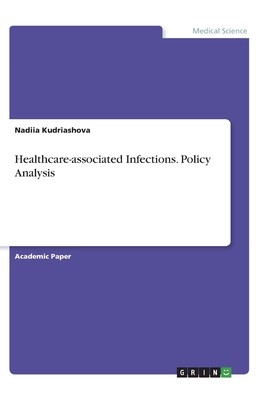
- We will send in 10–14 business days.
- Author: Nadiia Kudriashova
- Publisher: GRIN Verlag
- Year: 2019
- Pages: 20
- ISBN-10: 3346022005
- ISBN-13: 9783346022004
- Format: 14 x 21.6 x 0.1 cm, minkšti viršeliai
- Language: English
- SAVE -10% with code: EXTRA
Healthcare-associated Infections. Policy Analysis (e-book) (used book) | bookbook.eu
Reviews
Description
Academic Paper from the year 2017 in the subject Health - Nursing Science - Miscellaneous, grade: -, Medical College of Georgia, language: English, abstract: Nosocomial infections, having arisen at the dawn of the first medical institutions, became an increasingly complex and urgent problem of medicine. In modern conditions, the incidence of nosocomial infections, to a certain extent, reflects the quality of medical care provided to the population and is one of the important components of economic damage in practical health care. According to research conducted by a single methodology under the auspices of WHO in fourteen countries, an average 8% of hospitalized patients infections are infected with with nosocomial infections. In the European region, the incidence of nosocomial infections is more than 7%, in the United States - about 5%; mortality is 2.7% (El-Saed, Balkhy, & Weber, 2013). The most common variants of nosocomial infections include nosocomial pneumonia, urinary tract infections, catheter-associated infections, and pseudomembranous colitis, or antibiotic-associated diarrhea. It should be understood that the localization of nosocomial infection depends on both the etiology of the pathogen and the source of nosocomial infections. Approximately 1 in 10 cases ends in death (Boev & Kiss, 2016). However, at least half of the infections are preventable. Policies and programs to combat nosocomial infections are aimed at this prevention.
EXTRA 10 % discount with code: EXTRA
The promotion ends in 22d.20:46:04
The discount code is valid when purchasing from 10 €. Discounts do not stack.
- Author: Nadiia Kudriashova
- Publisher: GRIN Verlag
- Year: 2019
- Pages: 20
- ISBN-10: 3346022005
- ISBN-13: 9783346022004
- Format: 14 x 21.6 x 0.1 cm, minkšti viršeliai
- Language: English English
Academic Paper from the year 2017 in the subject Health - Nursing Science - Miscellaneous, grade: -, Medical College of Georgia, language: English, abstract: Nosocomial infections, having arisen at the dawn of the first medical institutions, became an increasingly complex and urgent problem of medicine. In modern conditions, the incidence of nosocomial infections, to a certain extent, reflects the quality of medical care provided to the population and is one of the important components of economic damage in practical health care. According to research conducted by a single methodology under the auspices of WHO in fourteen countries, an average 8% of hospitalized patients infections are infected with with nosocomial infections. In the European region, the incidence of nosocomial infections is more than 7%, in the United States - about 5%; mortality is 2.7% (El-Saed, Balkhy, & Weber, 2013). The most common variants of nosocomial infections include nosocomial pneumonia, urinary tract infections, catheter-associated infections, and pseudomembranous colitis, or antibiotic-associated diarrhea. It should be understood that the localization of nosocomial infection depends on both the etiology of the pathogen and the source of nosocomial infections. Approximately 1 in 10 cases ends in death (Boev & Kiss, 2016). However, at least half of the infections are preventable. Policies and programs to combat nosocomial infections are aimed at this prevention.


Reviews